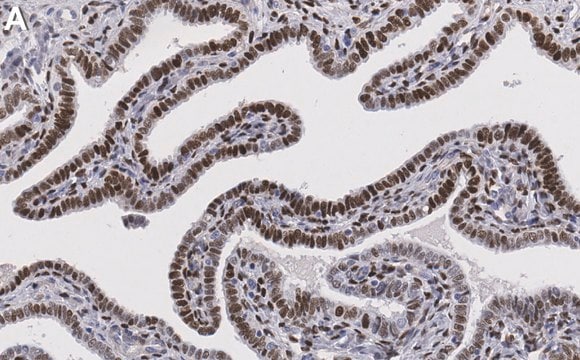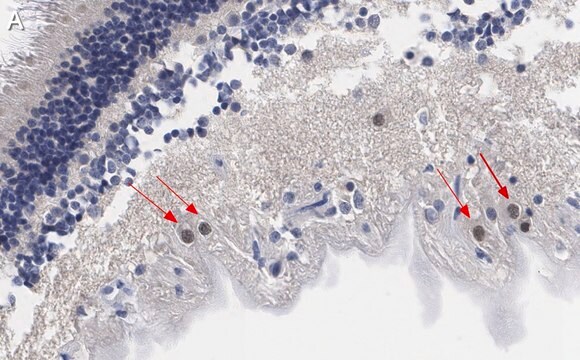一般說明
We are committed to bringing you greener alternative products, which adhere to one or more of The 12 Principles of Green Chemistry.This antibody is Preservative-free, produced without the harm or sacrifice of animals and exceptionally stable to allow for ambient shipping and storage if needed and thus aligns with "Waste Prevention", "Designing Safer Chemicals" and "Design for Energy Efficiency".
Click here for more information.
ZooMAb® antibodies represent an entirely new generation of recombinant monoclonal antibodies.
Each ZooMAb® antibody is manufactured using our proprietary recombinant expression system, purified to homogeneity, and precisely dispensed to produce robust and highly reproducible lot-to-lot consistency. Only top-performing clones are released for use by researchers. Each antibody is validated for high specificity and affinity across multiple applications, including its most commonly used application. ZooMAb® antibodies are reliably available and ready to ship when you need them.
特異性
Clone 1K7 is a ZooMAb® Rabbit recombinant monoclonal antibody that specifically detects Eukaryotic translation initiation factor 4E (eIF-4E). It targets an epitope within 25 amino acids from the N-terminal region.
免疫原
KLH-conjugated linear peptide corresponding to 25 amino acids from the N-terminal region of human Eukaryotic translation initiation factor 4E (eIF-4E).
應用
Quality Control Testing
Evaluated by Western Blotting in U2OS cell lysate.
Western Blotting Analysis: A 1:1,000 dilution of this antibody detected eIF-4E in U2OS cell lysate.
Tested applications
Western Blotting Analysis: A 1:1,000 dilution from a representative lot detected eIF-4E in HEK293, and Cos7 cell lysates.
Affinity Binding Assay: A representative lot of this antibody bound eIF-4E peptide with a KD of 1.5 x 10-6 in an affinity binding assay.
Immunohistochemistry (Paraffin) Analysis: A 1:100 dilution from a representative lot detected eIF-4E in human cerebral cortex tissue sections.
Immunocytochemistry Analysis: A 1:100 dilution from a representative lot detected eIF-4E in U2OS cells.
Note: Actual optimal working dilutions must be determined by end user as specimens, and experimental conditions may vary with the end user
標靶描述
Eukaryotic translation initiation factor 4E (UniProt: P06730; also known as eIF-4E, eIF4E, eIF-4F 25 kDa subunit, mRNA cap-binding protein) is encoded by the EIF4E (also known as EIF4EL1, EIF4F) gene (Gene ID: 1977) in human. eIF-4E, a member of the eukaryotic initiation factor 4E family, is a cytoplasmic factor that recognizes and binds the 7-methylguanosine-containing mRNA cap during an early step in the initiation of protein synthesis and facilitates ribosome binding by inducing the unwinding of the mRNAs secondary structures. It contains four 7-methylguanosine-containing mRNA cap binding regions (aa 56-57; 102-103; 157-162; 205-207) and three EIF4EBP1/2/3 binding regions (aa 37-40; 73-77; 132-139).It is a component of the CYFIP1-EIF4E-FMR1 complex that binds to the mRNA cap and mediates translational repression. Its function is tightly regulated in cells under normal physiological conditions and can be controlled by post-translational modifications, such as phosphorylation, and by the binding of inhibitory proteins, including eIF4E binding proteins (EIF4EBPs). The PI3-K/mTOR pathway is reported to regulate eIF-4E function via the action of EIF4BPs. Phosphorylation of eIF-4E increases its ability to bind to mRNA caps and to form the eIF4F complex. Hypophosphorylated EIF4EBP1/2/3 are shown to compete with EIF4G1/EIF4G3 to interact with elF-4E. Phosphorylation of ElF4EBP1 by insulin-stimulated MAP kinases (MAPK1 and MAPK3) cause dissociation of the complex and allow EIF4G1/EIF4G3 to bind and result in initiation of translation. Three isoforms of elf-4E have been described that are generated by alternative splicing. Mutations in ElF4E gene have been linked to autism with impairments in social interaction and communication and developmental abnormalities. Overexpression of eIF-4E overexpression is observed in human breast, head and neck, colon, prostate, bladder, cervix, and lung cancers and has been linked to disease progression. This ZooMAb® recombinant monoclonal antibody, generated by our propriety technology, offers significantly enhanced specificity, affinity, reproducibility, and stability over conventional monoclonals. (Ref.: Amorim, IS., et al. (2018). Front. Genet. 9; 561; Benedetti, AD., and Graff, JR. (2004). Oncogene. 23(18); 3189-3199).
外觀
Purified recombinant rabbit monoclonal antibody IgG, lyophilized in PBS, 5% Trehalose, normal appearance a coarse or translucent resin. The PBS/trehalose components in the ZooMAb formulation can have the appearance of a semi-solid (bead like gel) after lyophilization. This is a normal phenomenon. Please follow the recommended reconstitution procedure in the data sheet to dissolve the semi-solid, bead-like, gel-appearing material. The resulting antibody solution is completely stable and functional as proven by full functional testing. Contains no biocide or preservatives, such as azide, or any animal by-products. Larger pack sizes provided as multiples of 25 μL.
重構
300 μg/mL after reconstitution at 25 μL per vial. Please refer to guidance on suggested starting dilutions and/or titers per application and sample type.
儲存和穩定性
Recommend storage of lyophilized product at 2-8°C; Before reconstitution, micro-centrifuge vials briefly to spin down material to bottom of the vial; Reconstitute each vial by adding 25 μL of filtered lab grade water or PBS; Reconstituted antibodies can be stored at 2-8°C, or -20°C for long term storage. Avoid repeated freeze-thaws.
法律資訊
ZooMAb is a registered trademark of Merck KGaA, Darmstadt, Germany
免責聲明
Unless otherwise stated in our catalog or other company documentation accompanying the product(s), our products are intended for research use only and are not to be used for any other purpose, which includes but is not limited to, unauthorized commercial uses, in vitro diagnostic uses, ex vivo or in vivo therapeutic uses or any type of consumption or application to humans or animals.









